China Digital
Digital Diplomacy: These Foreign Embassies Are Most (Un)Popular on Weibo
‘Weiplomacy’ is here; Weibo and other social media platforms are a tool for government public diplomacy purposes. What’s on Weibo gives an overview of Weibo’s most (un)popular foreign embassies.
Published
7 years agoon
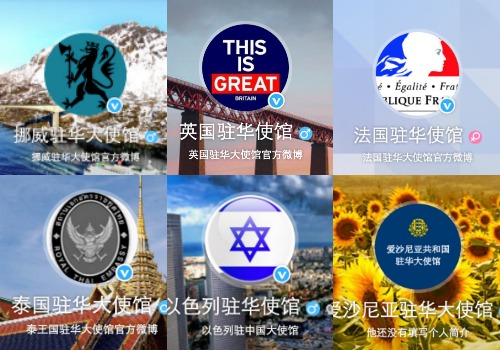
As social media has become an increasingly common tool for government public diplomacy purposes, a large number of foreign embassies in China now has a presence on Sina Weibo to engage with local audiences. As Weibo diplomacy a.k.a. ‘Weiplomacy’ is becoming more important, What’s on Weibo gives an overview of Weibo’s most (un)popular foreign embassies.
Digital diplomacy is a hot topic. Embassies all over the world increasingly use social media as a low-cost and convenient tool to promote their countries, inform people about their latest activities and engage with their followers.
Many embassies can be found on Facebook, Twitter or Youtube, but also on China’s Sina Weibo or WeChat, changing the way foreign embassies engage with with local audiences in China.
E-Diplomacy: Up & Downsides
Foreign embassies on Weibo have recently been getting more scholarly attention. In “Social Media and E-Diplomacy: Scanning Embassies on Weibo” (2017), Ying Jiang writes that social media is an effective way for embassies to communicate to target groups, more so than conventional (offline) public diplomacy.
However, Jiang also points out that the presence of foreign embassies on Weibo has its downsides, as web users can vent their anger and post negative comments to embassy pages if they are against the policies of those countries.
This is especially apparent on embassy pages such as that of the Japanese embassy in China, where people often leave anti-Japanese comments and pictures related to the Sino-Japanese war.
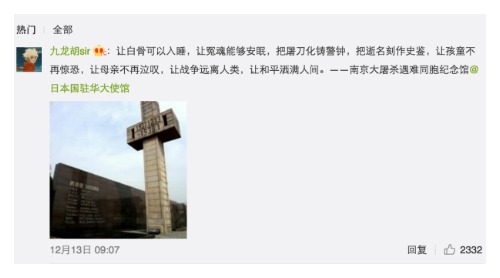
Comments on the page of the Japanese embassy in China related to WWII.
But there are also countless negative comments on pages of other embassies. On the Weibo page of the German embassy in China, for example, Weibo users have posted many critiques on the country’s refugee policies after a post about new visa announcements. One netizen says: “If Germany doesn’t solve its refugee problem, the country has zero attractiveness anymore.”
On the USA embassy page, netizens leave comments such as: “The US truly is an evil country. You’re the world’s biggest terrorist organization.”
But visitors also often leave words of praise to embassy accounts. On the Danish embassy’s account, for example, some call Denmark “a magical place”, with the “land of fairytales” seemingly captivating the minds of many Chinese netizens.
When Thailand’s king passed away in October 2016, the Thai embassy page on Weibo was filled with condolences from Chinese expressing their grief and stressing the friendship between the Chinese and Thai.
Ying Jiang’s research calculated the number of reactions to every post on Weibo’s embassies with the most followers and found that even if an embassy had the most followers, it was not necessarily most influential based on their received comments and amount of post shares.
According to Ying Jiang’s data, which was collected in the first half of 2015, the Canadian embassy had the largest following on Sina Weibo, followed by the USA, Cuba, UK and South Korea, with the latter being most influential based on its interactions with its followers.
It seems that things have changed over the past two years, as the following list of foreign embassies collected and compiled by What’s on Weibo shows a different order of popularity.
Weibo’s Top 5 Embassies
Although the Canadian, Cuban, US and South Korean embassies are still popular in terms of followers on Weibo, the Brazilian, Japanese, and especially Israeli embassies now have the highest number of fans on Weibo.
The popularity of the Canadian embassy on Weibo can undoubtedly partly be attributed to the strong promotion of China-Canada friendship, the popularity of Canadian Prime Minister Justin Trudeau, and perhaps even the great popularity of the Canadian doctor Norman Bethune, who is honored in China for his role as a battleground surgeon during the Second Sino-Japanese War.
But most importantly, Canada’s success on Weibo is a result of its own endeavors on Chinese social media. In a DiploFoundation interview with Mark McDowell, Counsellor of the Canadian Embassy in Beijing, McDowell stresses the importance of the so-called ‘weiplomacy’ (微郊外 Weibo diplomacy) to the Canadian embassy, that has boosted its efforts in using social media as an efficient form of public diplomacy.
McDowell says the Canadian embassy in China posts about 20 to 30 Weibo messages per week, on topics varying from business news to visa issues, the ways Canada measures air pollution, or information about studying in Canada – all topics that interest their large group of followers on Weibo.*
But the current most popular embassy on Weibo is not Canada, nor Cuba or any of the biggest embassies mentioned in Ying Jiang’s 2015 research; it is the Embassy of Israel, that currently has over 1.9 million fans on its Weibo page, where it has posted a total of 3590 posts at the time of writing (in comparison: the Canadian embassy had posted 6979 posts at this time).
Top five according to What’s on Weibo, December 2016:
1. Israeli embassy (@以色列驻华使馆) – 1.913.384 followers
2. Canadian embassy (@加拿大大使馆官方微博)
– 1.131.700+ followers
3. US embassy (@美国驻华大使馆) – 1.035.300+ followers
4. Brazilian embassy (@巴西驻华大使馆) – 522.310+ followers
5. Japanese embassy (@日本国驻华大使馆) – 480.500+ followers
Why is Israel so popular on Weibo?
What makes the Embassy of Israel so popular on Weibo? Overall, Chinese netizens seem to have a positive attitude towards the country. It is, among others, shared memories of the history of WWII that have contributed to the present strong relations between China and Israel.
In 2015, the Consulate General of Israel in Shanghai published a video that featured hundreds of Israelis holding “Thank you” signs in Chinese as a sign of gratitude for Shanghai helping the Jews during WWII. It also included a message from Prime Minister Benjamin Netanyahu expressing thanks to the Chinese people.
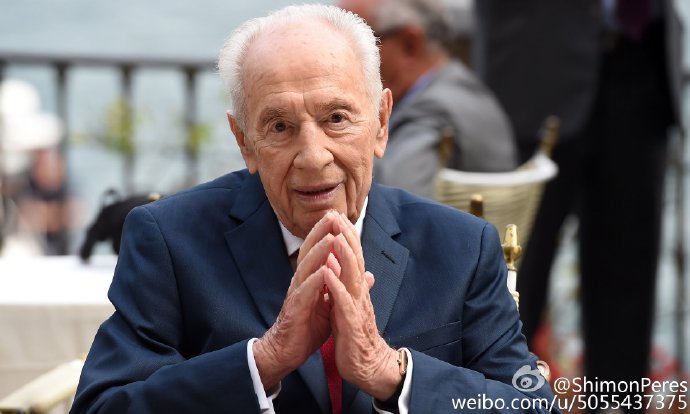
Shimon Peres, former President of Israel.
In 2014, late Israeli president Shimon Peres became a trending topic on Weibo when he registered for an account and met with Chinese president Xi Jinping. The “handsome old president” was warmly welcomed by Weibo users. One netizen said: “Israel really has been very good to China. During World War II, China took in a lot of Jewish refugees helping them avoid the disaster of war, and now this ethnicity truly knows how to be thankful. This is the kind of country that China should foster good relations with, and whether it be Israel or Pakistan, these are the true brothers of China. Anyway, this president is truly so adorable, and I just love adorable uncles [older men]” (China Smack 2014).
In 2014, the Australian reported that Israeli president Shimon Peres was one of the few Western leaders maintaining a social media presence in China, and that he had over 450,000 followers. When Peres passed away in September 2016, many web users visited the Israeli embassy account to share their condolences, praising the former president as a friend of China.

Web users lighting digital candles for Peres and posting their condoleances on the Israeli Embassy Weibo site.
According to Robert Lakin (@LakinTLV), founder of Analytika Research, Israel’s popularity on Weibo is a case of cause and effect.
“The Israel Foreign Ministry has really stepped up its game on social media,” Lakin tells What’s on Weibo: “The Israel Defense Force’s has also boosted its use of social media. As the country puts out more buzz-worthy content, the effect is a jump in social followers. This includes lots of peripheral, one-off activity, too.” Lakin also mentions the influence of the Times of Israel‘s Chinese language website, which might have contributed to the Israeli success on Weibo.
What About the ‘Unpopular’ Foreign Embassies?
With countries such as Israel and Canada having a relatively positive image among Chinese people – which also reflects in their popularity on social media – does this mean that the lowest-ranking foreign embassies on Weibo also are of those nations that have a less positive reputation in China?
Not necessarily so. According to What’s on Weibo, the embassies of Estonia, Monaco and Indonesia have the lowest number of followers on Weibo, but this also has to do with the low activity on the concerning accounts; Estonia last posted in 2012, Indonesia in 2014, whereas Monaco has just posted its 75 first posts on the social media platform.
List of Foreign Embassies on Weibo
This is the list of foreign embassies currently present on Sina Weibo, from most popular to less popular in terms of followers. The great majority of these accounts have all been verified by Sina Weibo as the official embassy of their country (‘V’ status); if not, it has been noted.
---
1. Israeli embassy (@以色列驻华使馆) 1.913.384 followers
2. Canadian embassy (@加拿大大使馆官方微博) 1.131.700+ followers
3. US embassy (@美国驻华大使馆) 1.035.300+ followers
4. Brazilian embassy (@巴西驻华大使馆) 522.310+ followers
5. Japanese embassy (@日本国驻华大使馆) 480.500+ followers
6. South-Korean embassy (@韩国驻华大使馆) 396.960+ followers
7. Cuban embassy (@古巴驻华大使馆) 358.950+ followers
8. British embassy (@英国大使馆文化教育处) 289.280+ followers
9. French embassy (@法国驻华使馆) 255.240+ followers
10. Russian embassy (@俄罗斯驻华大使馆) 167.539+ followers
11. Australian embassy (@澳大利亚驻华使领馆) 165.240+ followers
12. German embassy (@德国驻华大使馆) 147.230+ followers
13. Embassy of Myanmar (@中缅胞波兄弟情) 146.000 followers
14. Danish embassy (@中缅胞波兄弟情) 丹麦驻华大使馆) 139.760+ followers
15. Thai embassy (@泰国驻华大使馆) 104.570+ followers
16. Swiss embassy (@瑞士驻华大使馆) 99.190+ followers
17. Swedish embassy (@瑞典驻华大使馆微博) 68.310+ followers
18. Dutch embassy (@荷兰驻华大使馆) 68.070+ followers
19. Mexican embassy (@墨西哥驻华大使馆) 50.160+ followers
20. Belgian embassy (@比利时驻华使馆) 49585+ followers
21. Italian embassy (@意大利驻华使馆) 46.330+ followers
22. Polish embassy (@波兰使馆文化处) 39185+ followers
23. Nepal embassy (@尼泊尔大使馆官方微博) 37.177+ followers
24. New Zealand embassy (@新西兰驻华大使馆) 37.140+ followers
25. Mauritanian embassy (@毛里塔尼亚驻华大使馆) 36.545+ followers
26. Zimbabwean embassy (@中国驻津巴布韦大使馆) 35.450+ followers
27. Costa Rican embassy (@哥斯达黎加驻华大使馆) 34.930+ followers
28. Peruvian Embassy (@秘鲁驻华使馆) 33.507 followers
29. Portugese embassy (@葡萄牙驻华大使馆) 28.380+ followers
30. Maldives embassy (@马尔代夫驻华大使馆) 22.460+ followers
31. Indian embassy (@印度使馆文化处) 22.225+ followers
32. Irish embassy (@爱尔兰驻华大使馆) 20.191+ followers
33. Spanish embassy (@西班牙驻华大使馆官方微博) 16.030+ followers
34. Austrian embassy (@奥地利驻华使馆) 15.960+ followers
35. Norwegian embassy (@挪威驻华大使馆) 11.800+ followers
36. Turkish embassy / official tourism board (@土耳其旅游局) 67.430+ followers
37. Kazakhstan embassy (@哈萨克斯坦驻华大使馆) 12.670+ followers
38. Ukranian embassy (@乌克兰信使) 9960+ followers
39. Iranian Embassy (@伊朗驻华大使馆) 6166 followers [not verified]
40. Rwandan embassy (@卢旺达驻华大使馆) 5480+ followers
41. Lithuanian embassy (@立陶宛驻华大使馆商务处) 3170+ followers
42. Chilean embassy (@智利驻中国大使馆) 2540+ followers
43. Sri Lankan embassy (@中国驻斯里兰卡大使馆) 2109 followers
44. Egyptian embassy (@埃及驻华大使馆) [account not verified] 910+ followers (Note: the account of the official Egypt tourism board on Weibo has 28392 followers).
45. Estonian Embassy (@
46. Embassy of Monaco (@摩纳哥公国大使馆) 450+ followers
47. Indonesian Embassy (@印度尼西亚驻华大使馆) [account not verified] 350+ followers
---
With Sina Weibo currently seeing a revival and WeChat being China’s number one app, the use of these social media platforms in digital diplomacy is essential for foreign embassies wanting to engage with millions of Chinese – not just for the sake of providing information about traveling, arranging visas, or studying abroad, but also for the mere purpose of boosting their nation’s image in China.
With China’s online population growing as we write, and its social media features getting more versatile by the day, this might just be the beginning of China’s digital platforms being used as a diplomatic tool for foreign embassies.
Please follow us to stay up-to-date on more articles on this topic in the near future.
– By Manya Koetse
Follow on Twitter or Like on Facebook
*According to Globe and Mail, not all of the Canadian embassy’s followers are actually ‘real’; in a 2014 article, the website alleged that nearly 87% of the Canadian embassy account fans are ‘zombies’; fake accounts that do not represent actual persons. The Canadian government, however, stated it had never paid for the alleged fake followers and that it does not know where they come from. Note that for this article, we have not done any research into ‘fake followers’ and do not know if the top-ranking embassies have fake followers, and if so, how many there would be.
References
Bjola, Corneliu and Marcus Holmes (ed). 2015. Digital Diplomacy: Theory and Practice. Routledge: London and New York.
Cai, Peter. 2014. “How Israel is winning the social media war in China.” The Australian, September 2 http://www.theaustralian.com.au/business/business-spectator/how-israel-is-winning-the-social-media-war-in-china/news-story/08fb25d94b34b3036616c0334531ddc6 [20.12.16].
Jiang, Ying. 2017. “Social Media and E-Diplomacy: Scanning Embassies on Weibo.” In: Naren Chitty, Li Ji, Gary D. Rawnsley, Craig Hayden (ed), The Routledge Handbook of Soft Power. New york: Routledge: New York.
Rugh, William A. 2014. Front Line Public Diplomacy: How US Embassies Communicate with Foreign Publics. New York: Palgrave Macmillan.
What’s on Weibo is an independently run news blog. We accept donations to help us keep the site going. Donating is possible via www.paypal.me/whatsonweibo.
©2016 Whatsonweibo. All rights reserved. Do not reproduce our content without permission – you can contact us at info@whatsonweibo.com.
Manya Koetse is the founder and editor-in-chief of whatsonweibo.com. She is a writer, public speaker, and researcher (Sinologist, MPhil) on social trends, digital developments, and new media in an ever-changing China, with a focus on Chinese society, pop culture, and gender issues. She shares her love for hotpot on hotpotambassador.com. Contact at manya@whatsonweibo.com, or follow on Twitter.

China Arts & Entertainment
Going All In on Short Streaming: About China’s Online ‘Micro Drama’ Craze
For viewers, they’re the ultimate guilty pleasure. For producers, micro dramas mean big profit.
Published
3 weeks agoon
March 26, 2024By
Ruixin Zhang
PREMIUM CONTENT
Closely intertwined with the Chinese social media landscape and the fast-paced online entertainment scene, micro dramas have emerged as an immensely popular way to enjoy dramas in bite-sized portions. With their short-format style, these dramas have become big business, leading Chinese production studios to compete and rush to create the next ‘mini’ hit.
In February of this year, Chinese social media started flooding with various hashtags highlighting the huge commercial success of ‘online micro-short dramas’ (wǎngluò wēiduǎnjù 网络微短剧), also referred to as ‘micro drama’ or ‘short dramas’ (微短剧).
Stories ranged from “Micro drama screenwriters making over 100k yuan [$13.8k] monthly” to “Hengdian building earning 2.8 million yuan [$387.8k] rent from micro dramas within six months” and “Couple earns over 400 million [$55 million] in a month by making short dramas,” all reinforcing the same message: micro dramas mean big profits. (Respectively #短剧爆款编剧月入可超10万元#, #横店一栋楼半年靠短剧租金收入280万元#, #一对夫妇做短剧每月进账4亿多#.)
Micro dramas, taking China by storm and also gaining traction overseas, are basically super short streaming series, with each episode usually lasting no more than two minutes.
From Horizontal to Vertical
Online short dramas are closely tied to Chinese social media and have been around for about a decade, initially appearing on platforms like Youku and Tudou. However, the genre didn’t explode in popularity until 2020.
That year, China’s State Administration of Radio, Film, and Television (SARFT) introduced a “fast registration and filing module for online micro dramas” to their “Key Online Film and Television Drama Information Filing System.” Online dramas or films can only be broadcast after obtaining an “online filing number.”
Chinese streaming giants such as iQiyi, Tencent, and Youku then began releasing 10-15 minute horizontal short dramas in late 2020. Despite their shorter length and faster pace, they actually weren’t much different from regular TV dramas.
Soon after, short video social platforms like Douyin (TikTok) and Kuaishou joined the trend, launching their own short dramas with episodes only lasting around 3 minutes each.
Of course, Douyin wouldn’t miss out on this trend and actively contributed to boosting the genre. To better suit its interface, Douyin converted horizontal-screen dramas into vertical ones (竖屏短剧).
Then, in 2021, the so-called mini-program (小程序) short dramas emerged, condensing each episode to 1-2 minutes, often spanning over 100 episodes.
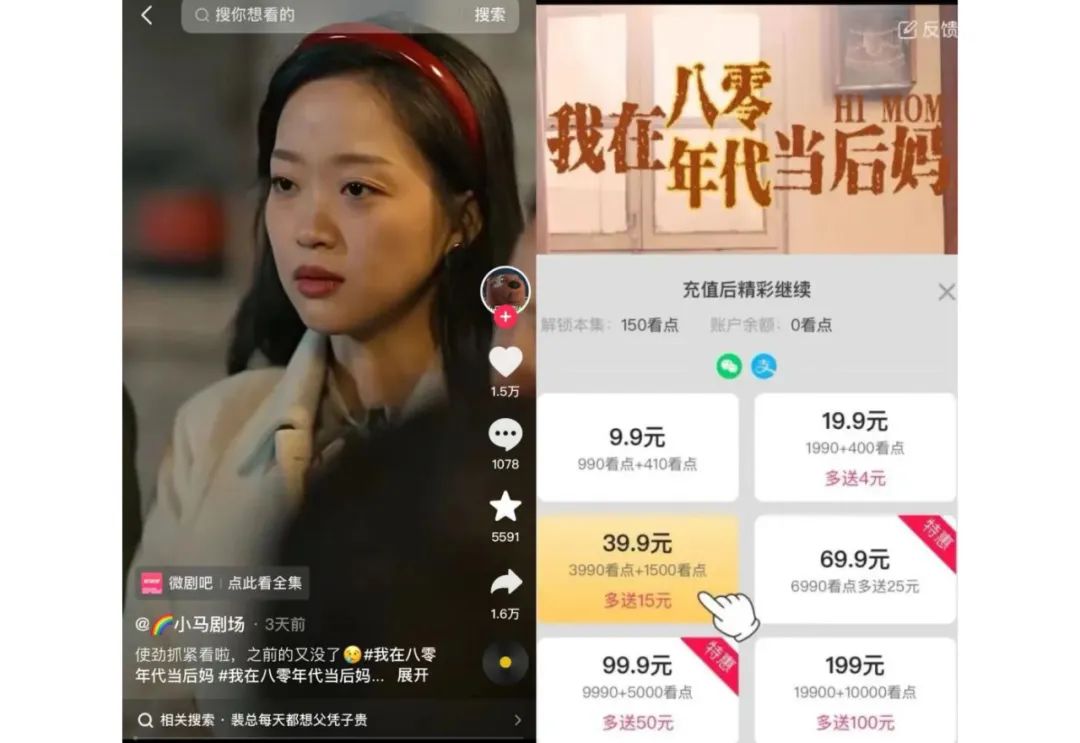
These short dramas are advertised on platforms like Douyin, and when users click, they are directed to mini-programs where they need to pay for further viewing. Besides direct payment revenue, micro dramas may also bring in revenue from advertising.
‘Losers’ Striking Back
You might wonder what could possibly unfold in a TV drama lasting just two minutes per episode.
The Chinese cultural media outlet ‘Hedgehog Society’ (刺猬公社) collected data from nearly 6,000 short dramas and generated a word cloud based on their content keywords.
In works targeted at female audiences, the most common words revolve around (romantic) relationships, such as “madam” (夫人) and “CEO” (总裁). Unlike Chinese internet novels from over a decade ago, which often depicted perfect love and luxurious lifestyles, these short dramas offer a different perspective on married life and self-discovery.
According to Hedgehog Society’s data, the frequency of the term “divorce” (离婚) in short dramas is ten times higher than “married” (结婚) or “newlyweds” (新婚). Many of these dramas focus on how the female protagonist builds a better life after divorce and successfully stands up to her ex-husband or to those who once underestimated her — both physically and emotionally.
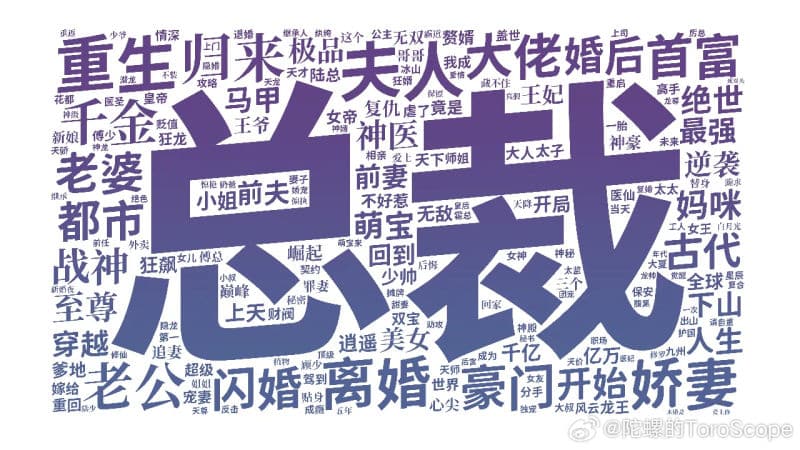
One of the wordclouds by 刺猬公社.
In male-oriented short dramas, the pursuit of power is a common theme, with phrases like “the strongest in history” (史上最强) and “war god” (战神) frequently mentioned. Another surprising theme is “matrilocal son” (赘婿), the son-in-law who lives with his wife’s family. In China, this term is derogatory, particularly referring to husbands with lower economic income and social status than their wives, which is considered embarrassing in traditional Chinese views. However, in these short dramas, the matrilocal son will employ various methods to earn the respect of his wife’s family and achieve significant success.
Although storylines differ, a recurring theme in these short dramas is protagonists wanting to turn their lives around. This desire for transformation is portrayed from various perspectives, whether it’s from the viewpoint of a wealthy, elite individual or from those with lower social status, such as divorced single women or matrilocal son-in-laws. This “feel-good” sentiment appears to resonate with many Chinese viewers.
Cultural influencer Lu Xuyu (@卢旭宁) quoted from a forum on short dramas, explaining the types of short dramas that are popular: Men seek success and admiration, and want to be pursued by beautiful women. Women seek romantic love or are still hoping the men around them finally wake up. One netizen commented more bluntly: “They are all about the counterattack of the losers (屌丝逆袭).”
The word used here is “diaosi,” a term used by Chinese netizens for many years to describe themselves as losers in a self-deprecating way to cope with the hardships of a competitive life, in which it has become increasingly difficult for Chinese youths to climb the social ladder.
Addicted to Micro Drama
By early 2024, the viewership of China’s micro dramas had soared to 120 million monthly active users, with the genre particularly resonating with lower-income individuals and the elderly in lower-tier markets.
However, short dramas also enjoy widespread popularity among many young people. According to data cited by Bilibili creator Caoxiaoling (@曹小灵比比叨), 64.9% of the audience falls within the 15-29 age group.
For these young viewers, short dramas offer rapid plot twists, meme-worthy dialogues, condensing the content of several episodes of a long drama into just one minute—stripping away everything except the pure “feel-good” sentiment, which seems rare in the contemporary online media environment. Micro dramas have become the ultimate ‘guilty pleasure.’

Various micro dramas, image by Sicomedia.
Even the renowned Chinese actress Ning Jing (@宁静) admitted to being hooked on short dramas. She confessed that while initially feeling “scammed” by the poor production and acting, she became increasingly addicted as she continued watching.
It’s easy to get hooked. Despite criticisms of low quality or shallowness, micro dramas are easy to digest, featuring clear storylines and characters. They don’t demand night-long binge sessions or investment in complex storylines. Instead, people can quickly watch multiple episodes while waiting for their bus or during a short break, satisfying their daily drama fix without investing too much time.
Chasing the gold rush
During the recent Spring Festival holiday, the Chinese box office didn’t witness significant growth compared to previous years. In the meantime, the micro drama “I Went Back to the 80s and Became a Stepmother” (我在八零年代当后妈), shot in just 10 days with a post-production cost of 80,000 yuan ($11,000), achieved a single-day revenue exceeding 2 million yuan ($277k). It’s about a college girl who time-travels back to the 1980s, reluctantly getting married to a divorced pig farm owner with kids, but unexpectedly falling in love.
Despite its simple production and clichéd plot, micro dramas like this are drawing in millions of viewers. The producer earned over 100 million yuan ($13 million) from this drama and another short one.

“I Went Back to the 80s and Became a Stepmother” (我在八零年代当后妈).
The popularity of short dramas, along with these significant profits, has attracted many people to join the short drama industry. According to some industry insiders, a short drama production team often involves hundreds or even thousands of contributors who help in writing scripts. These contributors include college students, unemployed individuals, and online writers — seemingly anyone can participate.
By now, Hengdian World Studios, the largest film and television shooting base in China, is already packed with crews filming short dramas. With many production teams facing a shortage of extras, reports have surfaced indicating significant increases in salaries, with retired civil workers even being enlisted as actors.
Despite the overwhelming success of some short dramas like “I Went Back to the 80s and Became a Stepmother,” it is not easy to replicate their formula. The screenwriter of the time-travel drama, Mi Meng (@咪蒙的微故事), is a renowned online writer who is very familiar with how to use online strategies to draw in more viewers. For many average creators, their short drama production journey is much more difficult and less fruitful.
But with low costs and potentially high returns, even if only one out of a hundred productions succeeds, it could be sufficient to recover the expenses of the others. This high-stakes, cutthroat competition poses a significant challenge for smaller players in the micro drama industry – although they actually fueled the genre’s growth.
As more scriptwriters and short dramas flood the market, leading to content becoming increasingly similar, the chances of making profits are likely to decrease. Many short drama platforms have yet to start generating net profits.
This situation has sparked concerns among netizens and critics regarding the future of short dramas. Given the genre’s success and intense competition, a transformation seems inevitable: only the shortest dramas that cater to the largest audiences will survive.
In the meantime, however, netizens are enjoying the hugely wide selection of micro dramas still available to them. One Weibo blogger, Renmin University Professor Ma Liang (@学者马亮), writes: “I spent some time researching short videos and watched quite a few. I must admit, once you start, you just can’t stop. ”
By Ruixin Zhang, edited with further input by Manya Koetse
Independently reporting China trends for over a decade. Like what we do? Support us and get the story behind the hashtag by subscribing:
Spotted a mistake or want to add something? Please let us know in comments below or email us. First-time commenters, please be patient – we will have to manually approve your comment before it appears.
©2024 Whatsonweibo. All rights reserved. Do not reproduce our content without permission – you can contact us at info@whatsonweibo.com.
China Brands, Marketing & Consumers
Tick, Tock, Time to Pay Up? Douyin Is Testing Out Paywalled Short Videos
Is content payment a new beginning for the popular short video app Douyin (China’s TikTok) or would it be the end?
Published
5 months agoon
November 18, 2023
The introduction of a Douyin novel feature, that would enable content creators to impose a fee for accessing their short video content, has sparked discussions across Chinese social media. Although the feature would benefit creators, many Douyin users are skeptical.
News that Chinese social media app Douyin is rolling out a new feature which allows creators to introduce a paywall for their short video content has triggered online discussions in China this week.
The feature, which made headlines on November 16, is presently in the testing phase. A number of influential content creators are now allowed to ‘paywall’ part of their video content.
Douyin is the hugely popular app by Chinese tech giant Bytedance. TikTok is the international version of the Chinese successful short video app, and although they’re often presented as being the same product, Douyin and Tiktok are actually two separate entities.
In addition to variations in content management and general usage, Douyin differs from TikTok in terms of features. Douyin previously experimented with functionalities such as charging users for accessing mini-dramas on the platform or the ability to tip content creators.
The pay-to-view feature on Douyin would require users to pay a certain fee in Douyin coins (抖币) in order to view paywalled content. One Douyin coin is equivalent to 0.1 yuan ($0,014). The platform itself takes 30% of the income as a service charge.
According to China Securities Times or STCN (证券时报网), Douyin insiders said that any short video content meeting Douyin’s requirements could be set as “pay-per-view.”
Creators, who can set their own paywall prices, should reportedly meet three criteria to qualify for the pay-to-view feature: their account cannot have any violation records for a period of 90 days, they should have at least 100,000 followers, and they have to have completed the real-name authentication process.
On Douyin and Weibo, Chinese netizens express various views on the feature. Many people do not think it would be a good idea to charge money for short videos. One video blogger (@小片片说大片) pointed out the existing challenge of persuading netizens to pay for longer videos, let alone expecting them to pay for shorter ones.
“The moment I’d need to pay money for it, I’ll delete the app,” some commenters write.
This statement appears to capture the prevailing sentiment among most internet users regarding a subscription-based Douyin environment. According to a survey conducted by the media platform Pear Video, more than 93% of respondents expressed they would not be willing to pay for short videos.

An online poll by Pear Video showed that the majority of respondents would not be willing to pay for short videos on Douyin.
“This could be a breaking point for Douyin,” one person predicts: “Other platforms could replace it.” There are more people who think it would be the end of Douyin and that other (free) short video platforms might take its place.
Some commenters, however, had their own reasons for supporting a pay-per-view function on the platform, suggesting it would help them solve their Douyin addiction. One commenter remarked, “Fantastic, this might finally help me break free from watching short videos!” Another individual responded, “Perhaps this could serve as a remedy for my procrastination.”
As discussions about the new feature trended, Douyin’s customer service responded, stating that it would eventually be up to content creators whether or not they want to activate the paid feature for their videos, and that it would be up to users whether or not they would be interested in such content – otherwise they can just swipe away.
Another social media user wrote: “There’s only one kind of video I’m willing to pay for, and it’s not on Douyin.”
By Manya Koetse
Get the story behind the hashtag. Subscribe to What’s on Weibo here to receive our newsletter and get access to our latest articles:
Spotted a mistake or want to add something? Please let us know in comments below or email us. First-time commenters, please be patient – we will have to manually approve your comment before it appears.
©2023 Whatsonweibo. All rights reserved. Do not reproduce our content without permission – you can contact us at info@whatsonweibo.com.
Subscribe

Chengdu Disney: The Quirkiest Hotspot in China

Where to Eat and Drink in Beijing: Yellen’s Picks

Weibo Watch: Burning BMWs

More than Malatang: Tianshui’s Recipe for Success

The Chinese Viral TikTok Song Explained (No, It’s Not About Samsung)

The ‘Two Sessions’ Suggestions: Six Proposals Raising Online Discussions

A Snowball Effect: How Cold Harbin Became the Hottest Place in China

Jia Ling Returns to the Limelight with New “YOLO” Movie and 110-Pound Weight Loss Announcement

Show-Inspired Journeys: Chinese Netizens Explore Next Travel Destination Through Favorite TV Series

Top 9 Chinese Movies to Watch This Spring Festival Holiday

Party Slogan, Weibo Hashtag: “The Next China Will Still Be China”

From Pitch to Politics: About the Messy Messi Affair in Hong Kong (Updated)

Weibo Watch: Frogs in Wells

Looking Back on the 2024 CMG Spring Festival Gala: Highs, Lows, and Noteworthy Moments

Two Years After MU5735 Crash: New Report Finds “Nothing Abnormal” Surrounding Deadly Nose Dive
Get in touch
Would you like to become a contributor, or do you have any tips or suggestions? Get in touch here!
Popular Reads
-

 China Insight1 month ago
China Insight1 month agoThe ‘Two Sessions’ Suggestions: Six Proposals Raising Online Discussions
-

 China Insight3 months ago
China Insight3 months agoA Snowball Effect: How Cold Harbin Became the Hottest Place in China
-

 China Arts & Entertainment3 months ago
China Arts & Entertainment3 months agoJia Ling Returns to the Limelight with New “YOLO” Movie and 110-Pound Weight Loss Announcement
-

 China Brands, Marketing & Consumers3 months ago
China Brands, Marketing & Consumers3 months agoShow-Inspired Journeys: Chinese Netizens Explore Next Travel Destination Through Favorite TV Series





Bjorn
December 21, 2016 at 1:32 pm
You forgot to add the EU Delegation to China to the list: 150 000+ followers 😀
James
December 24, 2016 at 3:40 pm
Is the Chinese 微郊外 correct? Should be 微外交 no?